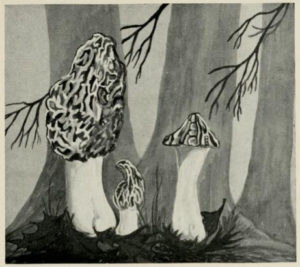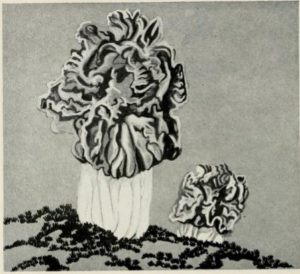The False Morel, a Dangerous Mushroom
Hunting for morel mushrooms is a favorite back-to-nature recreation for many Iowans, with bragging rights for the person who finds the most. Children are really good at this, being closer to the ground, and usually having better eyesight than us adults. And better than geocaching, you have to follow nature’s clues, and you get to eat the morels. My favorite morel dish so far has been lasagna, in which I omitted most of the flat pasta and substituted layers of thick-sliced morels.
But while you are out there in the woods, you might also encounter the false morel, AKA the Gyromitra, which appears at the same time as true morels. You might suppose that it is just a morel that grew up deformed, maybe a deer stepped on it, and add it to your catch, intending to eat it. This is a mistake.
It transpires that the false morel contains helvellic acid, and if eaten raw is deadly poisonous. The mechanism is that this acid breaks down the cell walls of red blood cells, which then disintegrate, leaving the victim with impaired (or no way) to deliver oxygen from the lungs to the rest of the body, becoming slowly or quickly dead depending upon how much they ate.
The spooky part of this story is that some people do eat these mushrooms without noticeable effects, and others only show symptoms after their third or fourth meal. I think that the answer to this puzzle lies not in any differences in body chemistry, because red blood cells are so much alike in all of us. Rather, helvellic acid is a durable organic molecule, which is only broken down slowly by heat or prolonged drying, and therefore edibility depends upon culinary practices. Historically, our culinary education was obtained at home, which could make it cultural Darwinism. If your clan had a safe way to prepare the false morel, you lived long enough to pass on both your genes and your cooking traditions, and if not, not.
The best written description I have encountered for Gyromitra is from the Illinois State Museum booklet: Exploring For Mushrooms by Virginia Eifert, “It is a semi-solid fungus whose stout stem is pure white and corded, as if it were made up of a group of smaller stems fused together. The top is deeply furrowed and twisted, not pitted as in the morel, and it is chestnut-red or red-brown, moist, and brittle. Inside, the Gyromitra is almost entirely solid; it is heavy in the hand and when dropped it shatters into pieces.”
These two sketches are also from that booklet:

The Morel family according to the Illinois Museum, but see comments which follow.

The Gyromitra. This sketch does not illustrate the many possible irregularities in the shape of the cap.
I offer you this note many weeks ahead of the morel season, so that if you need to learn how to better identify the false morel, there will be time to locate a reliable field guide, preferably an experienced person. Modern paper field guides also have a good selection of photos.
If you find a Gyromitra this spring, use it to improve your mycological experience. Drop it to watch it shatter, and cut the pieces apart to see how solid it is. Then repeat with a true morel, which will be lightweight and hollow and delicate by comparison.


